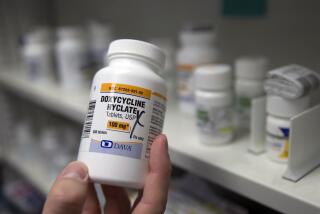Conclusion Based on San Francisco Study : Time May Increase AIDS Carriers’ Risk
- Share via
WASHINGTON — There is no evidence thus far that the danger of developing AIDS in an individual infected with the virus decreases over time--in fact, the opposite may be true, AIDS researchers will tell a federal advisory panel this week.
“If you could go to someone and say: ‘You’ve been infected for five years--the chances are now small that you’ll get sick,’ that would be comforting, but right now we can’t do that,” said Dr. Harold Jaffe, chief of the epidemiology branch of the AIDS program at the federal Centers for Disease Control.
“No one has yet followed a group over a period of years and seen the risk decrease,” he said in an interview.
Jaffe, who has been following a group of homosexual and bisexual men in San Francisco, said his sample showed a low risk for the onset of AIDS within the first few years of infection with HTLV-III, the virus that causes AIDS, but as time goes on the risk “substantially increases and persists for at least six years.”
Conference Opens Today
Jaffe and other experts will present their findings this week to a National Institutes of Health “consensus development conference” that opens today. The panel has been convened to examine the medical and social ramifications of the AIDS antibody blood test, introduced in the spring of 1985 to screen the nation’s blood supply, but now experiencing widening--and controversial--use as a diagnostic tool.
The panel is expected to issue recommendations addressing the effect of the screening test on the nation’s blood supply and the more sensitive issue of how to deal with the “psychosocial” impact of positive test results, particularly on blood donors.
However, the consequences of infection with the virus--the subject of debate and uncertainty since the disease was first identified in 1981--is also likely to be discussed at length.
Federal health officials have predicted that from 20% to 30% of those infected with the virus will develop AIDS over a period of five years.
“That’s the best we can do with information we have now,” Walter R. Dowdle, the coordinator for federal AIDS programs, said Sunday in an interview. “The next question is: What will the percentage be over a 10-year period? That we just don’t know.”
However, Dowdle added, as research into new AIDS drug therapies continues, “the longer you delay getting the disease, the more hope there is.” In this country, AIDS has killed more than half the 22,000 individuals who have contracted it.
San Francisco Study
Jaffe said that between 1978 and 1980 in San Francisco, 6,717 homosexual and bisexual men were involved in a series of studies of the hepatitis-B virus in which their blood samples were drawn and frozen. In 1984, the CDC and the San Francisco Public Health Department began looking at AIDS in this group. Of an estimated 4,700 members of the group who became infected, approximately 8% now have AIDS, Jaffe said.
Furthermore, Jaffe said, the CDC examined a subgroup of 57 men, of whom “we knew more precisely when they were infected,” and 18% now have AIDS. “The average duration of infection is five years,” he said. “Our conclusion is that there is an ongoing risk of illness in infected persons.”
AIDS, or acquired immune deficiency syndrome, cripples the immune system, leaving the body vulnerable to otherwise rare infections, cancers and neurological disorders.
The antibody test does not indicate whether a person has the disease, only whether he or she has been exposed to the virus. A person with a positive test, however, is considered infectious to others.
Jaffe said the “critical question” still to be answered is: “Once you’re infected, how does the risk of getting sick change over time?”
Two Possibilities
He continued: “There are two possibilities. The first is that it increases over time, and then decreases. The second--much worse--is that a certain percentage gets sick year after year, and the risk won’t decrease over time.”
He said that either situation is possible, “but no one has gotten to the point where the risk is decreasing.”
Jaffe said members of the San Francisco group “were, in retrospect, infected as early as 1978 and the prevalence of infection has increased rapidly since then.”
He said his study also has not yet found “any clear-cut behavioral thing that changes the risk (of developing the illness) once you’re infected.”
Dr. James J. Goedert, of the environmental epidemiology branch of the federal government’s National Cancer Institute, said in a paper to be presented to the panel this week that three to four years after infection, “approximately 90% of homosexual men and hemophiliacs” have seriously impaired immune systems as shown by a marked decrease in their T-4 helper cells, the immune system cells destroyed by the virus.
Like Jaffe, Goedert said that behavioral “co-factors do not appear to have a strong modifying effect on AIDS incidence.”
Also in his statement, he added: “Every effort must be made to prevent HTLV-III transmission and to intervene at an early stage of infection with . . . drugs” to attack the virus and rebuild the damaged immune system.






